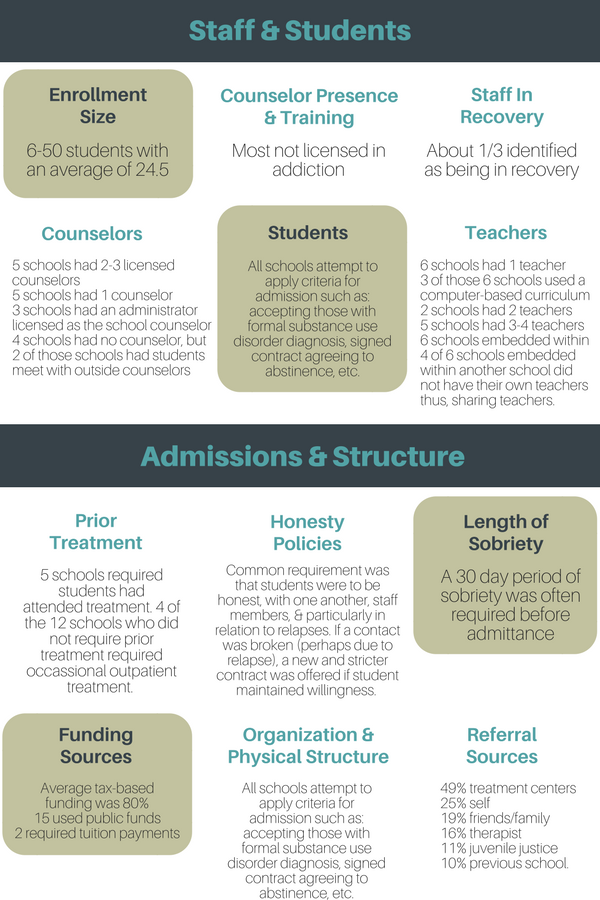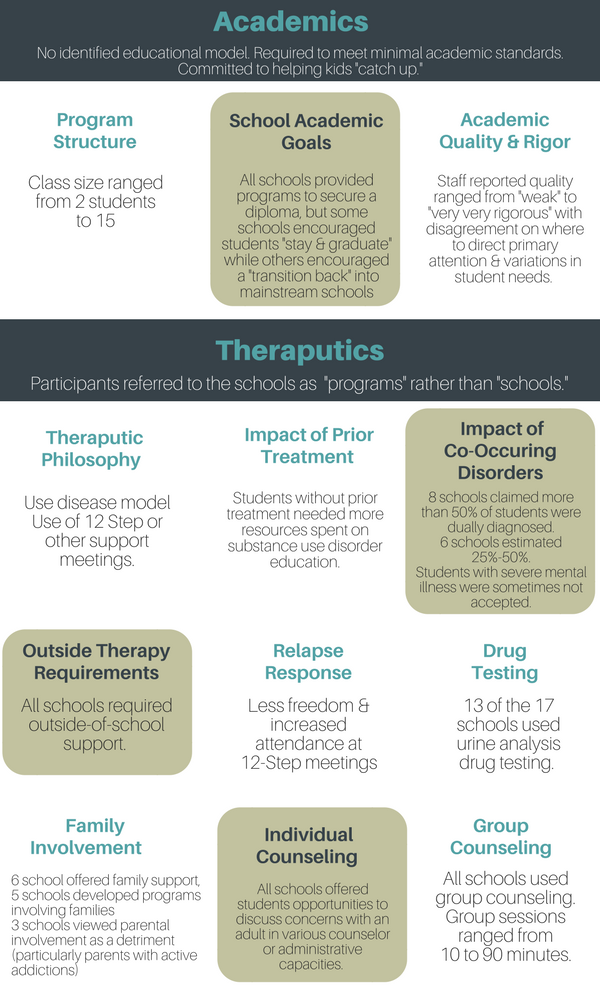A Closer Look at Common Characteristics of Recovery High Schools
High schools for students in recovery have been available for 35 years, and touted as helpful recovery support services. Little is known, however, descriptively regarding what these entities are and do. This study outlined how these organizations describe their own strengths and needs using a qualitative investigation.
WHAT PROBLEM DOES THIS STUDY ADDRESS?
High schools designed specifically for students in recovery from substance use disorder (i.e., “recovery high schools”) have been available since 1979 and attracted national attention on major media outlets. At the time of this study, there were 35 recovery high schools in operation and even more under consideration by states and foundations.
Traditionally, recovery high schools have been used as a continuum of care along the spectrum of treatment and recovery but there are no scientifically rigorous studies on their effectiveness. In addressing this knowledge gap, this study undertook the first scientific step by conducting a qualitative study of 17 recovery high schools. A previously released report described the student level outcomes and showed a significant reduction in substance use as well as mental health symptoms. This study complemented that prior work by focusing on the school level characteristics. The goal was to describe the differences and similarities among the recovery high schools and to identify challenges for their sustainability and expansion.
HOW WAS THIS STUDY CONDUCTED?
This study was conducted as an exploratory and descriptive analysis. The sample consisted of 17 high schools. Most schools fit the Association of Recovery Schools’ criteria and had been operating for at least 2 years. The data was collected in a 1-day site visit to each of 17 schools. Students and staff completed surveys, staff completed interviews, and observational data was recorded as well. Other forms of data included policy manuals, student handbooks, web sites, attendance reports, and other reports that were available to the study authors. Data collection occurred over three school semesters.
WHAT DID THIS STUDY FIND?


WHY IS THIS STUDY IMPORTANT
This qualitative study was important because it provided the first systematic description of recovery high school characteristics. Recovery high schools were found to vary in population size, physical arrangements, staffing, and financial arrangements. The schools struggle with academic rigor, institutional support, enrollment, funding, and lack of primary treatment accessibility.
For the students who have received treatment for substance use disorder, recovery high schools appear to be a continuing care service that support and extend the therapeutic tenets received in treatment. Given that most schools will accept students without prior treatment, the range of substance use disorder knowledge, motivation for recovery, and treatment for mental health can vary widely and affect the primary emphasis of the program (e.g., therapy versus education).
- LIMITATIONS
-
- This was primarily pilot and feasibility research; therefore, degree of effectiveness on substance use or educational outcomes were not included in this study.
- As with all qualitative research there are limitations inherit in the design. The information is meant to describe the schools included in the study and less for the purpose of generalizability.
- Furthermore, the brief site visits lasted 1 day and capture only a piece of overall school processes.
NEXT STEPS
Determining the effectiveness of recovery high schools on a range of outcomes, including long-term trajectories of substance use, educational attainment, quality of life, and identifying the best candidates to receive services from recovery high schools are important next steps. Potentially important design features might include a longitudinal framework that compared students leaving treatment and entering a recovery high school to students who are entering a regular high school. A longitudinal study of recovery high schools is ongoing.
BOTTOM LINE
- For individuals & families seeking recovery: This exploratory study from 17 recovery high schools suggests that the environments provided by recovery schools have the potential to support students along a continuum of needs that may be beyond the scope of regular high schools, and can do so for a length of time that treatment facilities are not designed to do. This study does not provide effectiveness results. Its findings suggests that if you or a family member are in recovery from a substance use disorder, and need to complete your high school education, a recovery high school may be an option to meet your needs. More research on the effectiveness of recovery high schools is needed to offer firm recommendations, however.
- For scientists: The results of this qualitative study of recovery high schools should be used to inform an empirical test of the effectiveness of recovery high schools on both educational and therapeutic outcomes in a longitudinal framework. Furthermore, these preliminary results could be used to identify the ingredients of a model of “best practices” for recovery high schools for the purposes of dissemination. For example, should the goal be to stay and graduate, or transition back into a regular high school?
- For policy makers: The results of this qualitative study suggests that recovery high schools may be a way for students beginning recovery to obtain a high school degree in a supportive environment that can mitigate threats to sobriety and graduation. Research targeted at identifying best practices for recovery high schools is needed so that new and existing schools can be effective and efficient in enhancing the health and well-being of young people affected by substance use disorder.
- For treatment professionals and treatment systems: This study of recovery high schools suggests that having a productive and varied referral base is an important need of the schools. If you have a recovery high school in your area, consider building and maintaining a relationship with them. It may help sustain a resource for adolescents in recovery from substance use disorder. More research is needed to determine the effectiveness of recovery high schools.
CITATIONS
Finch, A. J., Moberg, D.P, & Krupp, A.L. (2014). Continuing care in high schools: A descriptive study of recovery high school programs. Journal of Child & Adolescent Substance Abuse, 23(2), 116-129. DOI: 10.1080/1067828X.2012.751269
Featured image source: http://www.massrecoveryhs.org/

